Program On Hold
The additional interest by more manufacturers was not as great as hoped for. On August 30, 2018 SSA put the BedFax program on hold. All records are being kept in case there is renewed interest in this lear labeling program.
What You See Is What You Get
The above statement is the intent of Bedfax: to answer the question, “What’s in the mattress? This is done with a label that lists all the ingredients of the mattress and where they are.
What is Bedfax, and how did it begin?
 Bedfax says on its website, “Bedfax® is a not-for-profit voluntary Verification Program developed by the Specialty Sleep Association [SSA].” This is what SSA President Dale Read says: “[It’s] a third-party voluntary mattress industry contents disclosure label program.” The primary concern is transparency and accuracy in listing and labeling the ingredients in bedding products.
Bedfax says on its website, “Bedfax® is a not-for-profit voluntary Verification Program developed by the Specialty Sleep Association [SSA].” This is what SSA President Dale Read says: “[It’s] a third-party voluntary mattress industry contents disclosure label program.” The primary concern is transparency and accuracy in listing and labeling the ingredients in bedding products.
Bedfax did not pop up overnight, not even in a few months. It was unveiled at the Winter Market in Las Vegas, January 2016, after three years of development. But the story goes further back than that. It is the outgrowth of and successor to SSA’s Environmental & Safety Program.
Environmental & Safety Program

In 2010, the Specialty Sleep Association launched the Environmental & Safety Program (ESP). The goal of this program was not to enforce certain ecological and safety features and qualifications for specialty sleep mattress, but transparency in claims made in these areas, in other words, “truth in marketing.”
The SSA conducted consumer research resulting in the Environmental Claims Report in January 2010. This report showed almost half of consumers were concerned about mattress safety (in fires), about one in seven wanted a mattress without emissions, and more than three quarters would buy a mattress with an understandable and trustable claim of being environmentally friendly. In other words, there was a market demand for safe, healthful, and green.
The Specialty Sleep Association is an organization of manufacturers of specialty sleep mattresses (those using support other than innersprings). It began as an association of waterbed manufacturers, but expanded to include makers of adjustable air beds and foam mattresses. The certification and seals of the ESP were available to member firms, such as Boyd Specialty Sleep (the first company to be certified).
SSA called the ESP process, “self-certification.” Member firms affirmed that they would accurately label the materials used in their mattresses on a Consumer Disclosure Label (CDL). There were three levels, then four, each with a Green Seal. The expectations were higher for each level. The program ended with the launch of Bedfax. According to Read, “We are no longer a Levels program and we were NEVER a certification program.”
Why Bedfax?
In 2013 Dale Reed, the president of the Specialty Sleep Association (SSA), told Russell Bienenstock, Publisher and Editor of Furniture Today, that because “greenwashing” bred confusion over what is in a mattress, customers who were genuinely concerned about how healthful and eco-friendly their mattresses were needed a way to be sure of the contents of a mattress before buying it. He reasoned that not only the customer would benefit, but the mattress industry itself, especially those who made organic and eco-friendly mattresses free from toxins and including natural ingredients from sustainable sources.

What SSA developed was a label which lists the ingredients in each of five parts of the mattress: Top Fabric, Fabric, Quilt/Fill, Core, and Fire Retardant (FR) Barrier. One of the two versions of the Bedfax® Consumer Disclosure Label (CDL) also has a section for certifications. Here are the general definitions for these:
- Top Fabric – top layer of mattress fabric
- Fabric – outer top layer and cloth pilings
- Quilt/Fill – anything under the topper layers (e.g., the “comfort layer”, wool, cotton, foam, low-profile springs in topper, etc.)
- Core – substance layer (e.g., innersprings – open and encased, PU foam, latex foam, wool, horse hair, air-core, gel foam, steel springs, etc.)
- Fire Retardant (FR) Barrier – type of barrier used and location
- Third-party certifications achieved – according with each certification body’s requirements

The goal of Bedfax is transparency by mattress manufacturers and retailers. Many shoppers now read the labels on whatever they buy. This would give an edge among these consumers to those manufacturers who use the label.
Before the CDL can be approved, the manufacturer has to submit documentation and be willing to let mattresses be taken at random and tested. For the manufacturers, this is an opportunity to show what they have. For the retail sales associate, this simplifies answering the customer who asks, “What is in this mattress?” Just point to the tag and say, “It’s all here.” For the customer, it is knowing that What you see is what you get.
This label is still rather new. Bedfax was exhibited at furniture and bedding expositions, and at the 2017 World Market and at the next International Sleep Product Association’s ISPA EXPO. The hope was that it would result in more manufacturers joining. “What you see is what you get” is a good idea so consumers could know the answer to “What’s in the mattress?”

